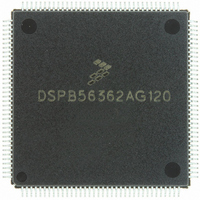DSPB56362AG120 Freescale Semiconductor, DSPB56362AG120 Datasheet - Page 114

DSPB56362AG120
Manufacturer Part Number
DSPB56362AG120
Description
IC DSP 24BIT AUD 120MHZ 144-LQFP
Manufacturer
Freescale Semiconductor
Series
Symphony™r
Type
Audio Processorr
Datasheet
1.DSPB56362AG120.pdf
(152 pages)
Specifications of DSPB56362AG120
Interface
Host Interface, I²C, SAI, SPI
Clock Rate
120MHz
Non-volatile Memory
ROM (126 kB)
On-chip Ram
42kB
Voltage - I/o
3.30V
Voltage - Core
3.30V
Operating Temperature
-40°C ~ 85°C
Mounting Type
Surface Mount
Package / Case
144-LQFP
Device Core Size
24b
Architecture
Modified Harvard
Format
Fixed Point
Clock Freq (max)
120MHz
Mips
120
Device Input Clock Speed
120MHz
Ram Size
42KB
Program Memory Size
90KB
Operating Supply Voltage (typ)
3.3V
Operating Supply Voltage (min)
3.14V
Operating Supply Voltage (max)
3.46V
Operating Temp Range
-40C to 105C
Operating Temperature Classification
Industrial
Mounting
Surface Mount
Pin Count
144
Package Type
LQFP
Product
DSPs
Data Bus Width
24 bit
Processor Series
DSP563xx
Core
56000
Numeric And Arithmetic Format
Fixed-Point
Instruction Set Architecture
Modified Harvard
Device Million Instructions Per Second
120 MIPS
Maximum Clock Frequency
120 MHz
Program Memory Type
Flash
Data Ram Size
42 KB
Operating Supply Voltage
3.3 V
Maximum Operating Temperature
+ 105 C
Mounting Style
SMD/SMT
Interface Type
SPI, I2C, ESAI, SHI
Minimum Operating Temperature
- 40 C
Lead Free Status / RoHS Status
Lead free / RoHS Compliant
Available stocks
Company
Part Number
Manufacturer
Quantity
Price
Company:
Part Number:
DSPB56362AG120
Manufacturer:
FSC
Quantity:
12 000
Company:
Part Number:
DSPB56362AG120
Manufacturer:
FREESCA
Quantity:
273
Company:
Part Number:
DSPB56362AG120
Manufacturer:
Freescale Semiconductor
Quantity:
10 000
Part Number:
DSPB56362AG120
Manufacturer:
N/A
Quantity:
20 000
Host Port Considerations
5.5.2
5-6
•
•
•
•
•
significance, the host could read the wrong combination. Therefore, read the bits twice and
check for consensus.
Overwriting the Host Vector—The host interface programmer should change the host vector
(HV) register only when the host command (HC) bit is clear. This ensures that the DSP interrupt
control logic will receive a stable vector.
Cancelling a Pending Host Command Exception—The host processor may elect to clear the HC
bit to cancel the host command exception request at any time before it is recognized by the DSP.
Because the host does not know exactly when the exception will be recognized (due to exception
processing synchronization and pipeline delays), the DSP may execute the host command
exception after the HC bit is cleared. For these reasons, the HV bits must not be changed at the
same time that the HC bit is cleared.
Variance in the Host Interface Timing—The host interface (HDI) may vary (e.g. due to the PLL
lock time at reset). Therefore, a host which attempts to load (bootstrap) the DSP should first make
sure that the part has completed its HI port programming (e.g., by setting the INIT bit in ICR then
polling it and waiting it to be cleared, then reading the ISR or by writing the TREQ/RREQ together
with the INIT and then polling INIT, ISR, and the HOREQ pin).
Synchronization of Status Bits from Host to DSP—DMA, HF1, HF0, HCP, HTDE, and HRDF
status bits are set or cleared by the host processor side of the interface. These bits are individually
synchronized to the DSP clock. (Refer to the user’s manual for descriptions of these status bits.)
Reading HF0 and HF1 as an Encoded Pair—Care must be exercised when reading status bits
HF0 and HF1 as an encoded pair, (i.e., the four combinations 00, 01, 10, and 11 each have
significance). A very small probability exists that the DSP will read the status bits synchronized
during transition. Therefore, HF0 and HF1 should be read twice and checked for consensus.
DSP Programming Considerations
DSP56362 Technical Data, Rev. 4
Freescale Semiconductor











